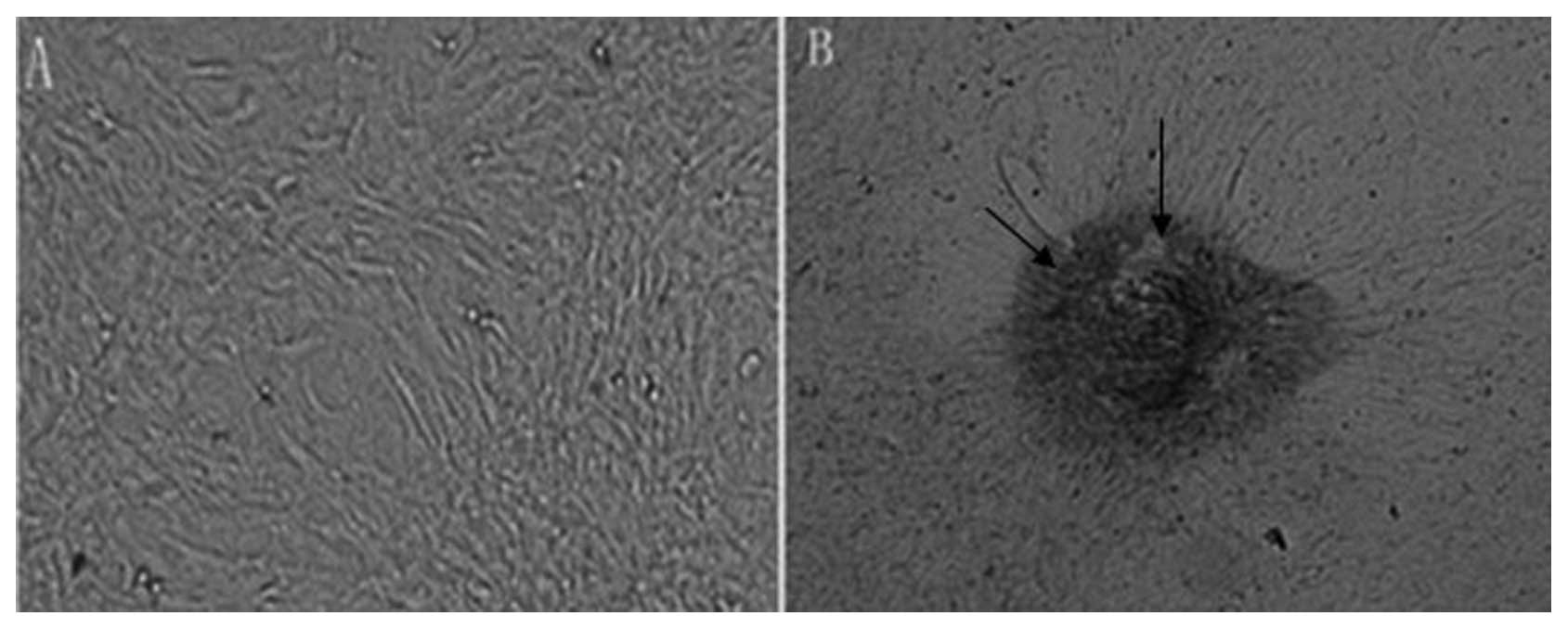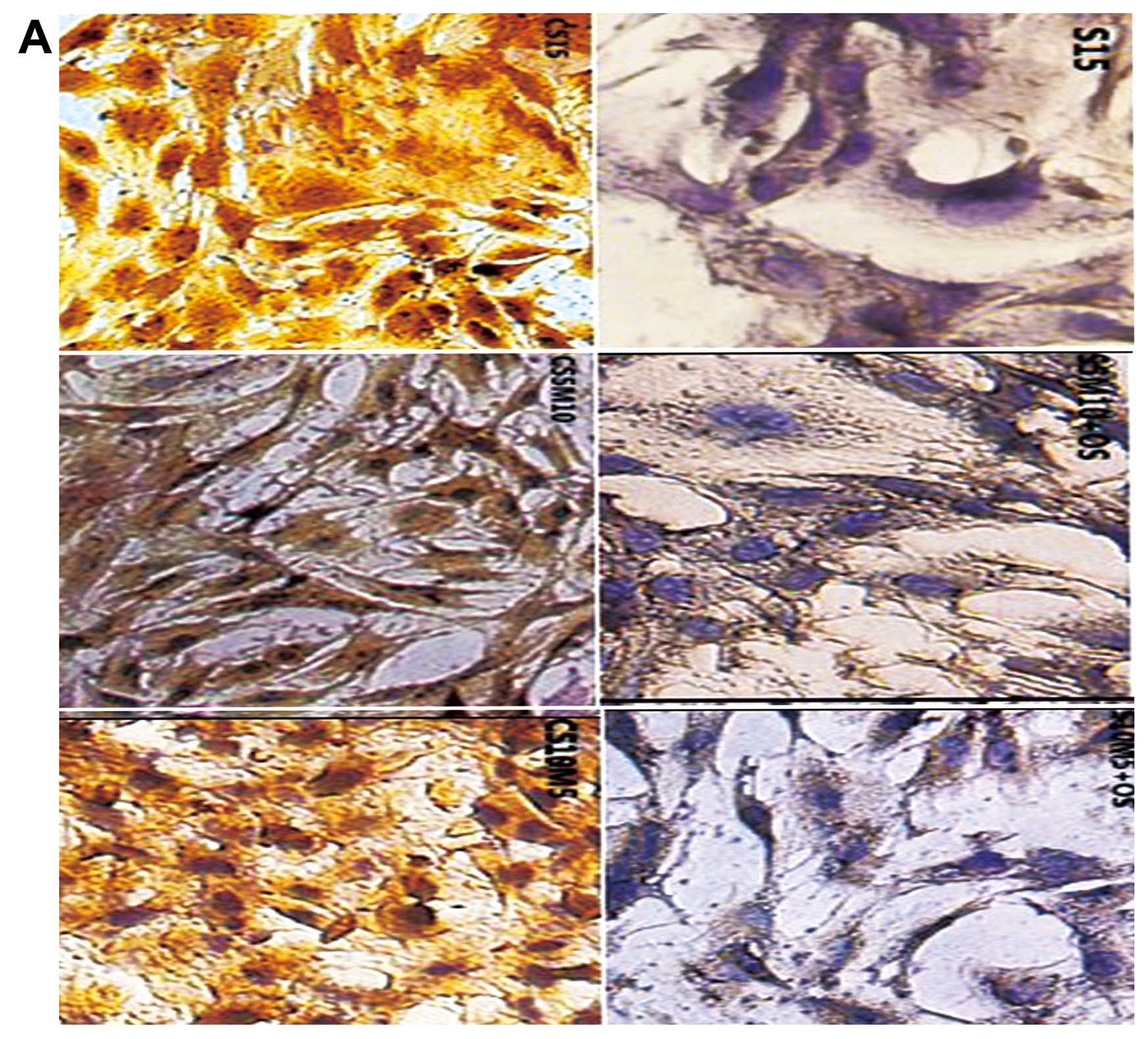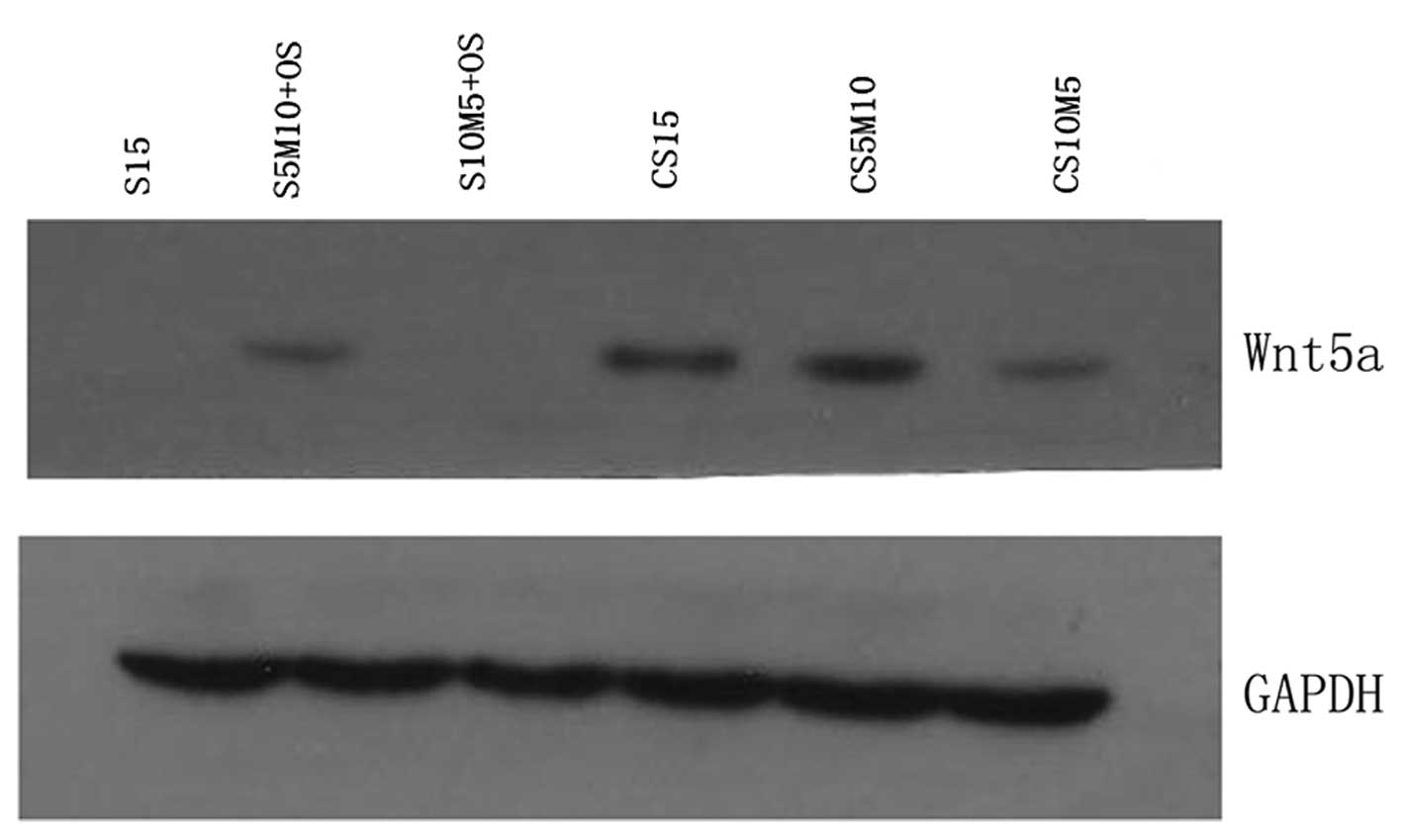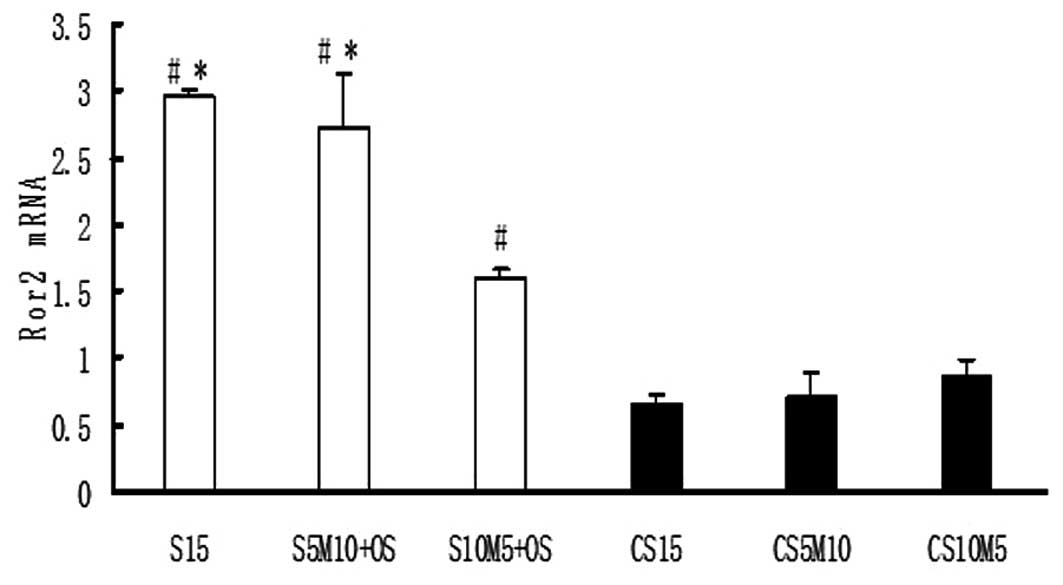Introduction
Vascular calcification affects our aging and dysmeta
bolic population (1). Vascular
calcification is known to be an actively regulated osteogenic
processes (2,3). An important step of osteogenic
processes is the osteochondrocytic differentiation of bone marrow
(BM)-derived mesenchymal stem cells (MSCs) (4). MSCs can be isolated from bone
marrow, harbor expansion potential, and differentiate into
mesenhymal cells, such as osteoblasts and chondrocytes (5), as well as into nonmesenchymal cells,
such as vascular cells (4,6,7).
Moreover, MSCs can enter the circulation and migrate into vascular
and other connective tissues (8),
especially at sites of injury and in tissue transplant grafts
(9–11).
MSCs are of increasing interest for future
therapeutic exploitation in the treatment of cardiovascular
diseases in the setting of allogeneic hematopoietic stem cell
transplantations (12). Although
it is attractive to consider that growth of MSC in injured vascular
tissue may simply regenerate normal vascular tissue, it is also
possible for these cells to produce ectopic tissues, such as those
observed in advanced atherosclerotic calcification (13). MSC are involved in the initiation
and progression of various vascular diseases (10). Notably, Wnt-signaling controls the
fate of MSCs, and plays an important role in vascular calcification
(4). MSCs also contribute to the
regulation of osteogenic mineralization during development and
disease and are therefore important in vascular calcification
(14,15). However, vascular calcification can
be inhibited by the non-canonical Wnt signaling pathway,
Wnt5a/Ror2. Therefore, it is important to determine whether this
pathway is associated with determination of the differentiation
fate of MSCs in vascular calcification, since few studies are
currently available regarding this novel method (17). In this study, we used an in
vitro cell-cell co-culturing system to observe whether MSCs
directly interact with vascular calcification and investigate the
Wnt5a/Ror2 pathway during the process.
Materials and methods
Rat bone-marrow-derived MSCs
The isolation and culture of male MSCs was performed
as described in a previous study (17). MSCs from the rats were allowed to
attach to culture flasks. After two days, non-attached cells were
washed away and the cells on flasks were cultured for 1–2 weeks
until near-confluence. MSCs were cultured in DMEM, supplemented
with 10% heat-inactivated FBS (both from Invitrogen Life
Technologies, Carlsbad, CA, USA), 100 U/ml penicillin and 100 Ag/ml
streptomycin at 37°C in 5% CO2 and 95% air using
trypsin-EDTA solution (Invitrogen Life Technologies) to digest and
detach MSCs. MSCs were used at passage three.
Rat aortic SMCs
Rat aortic SMCs (A-10, ATCC) were grown in
low-glucose DMEM. Osteosynthesis-inducing medium (OS), used only in
one osteoblastic differentiation assay, contained the above
described medium with 0.1 μM dexamethasone, 10 mM sodium
β-glycerol-phosphate and 0.05 mM ascorbic acid-2-phosphate
(Sigma-Aldrich, St. Louis, MO, USA). The culture medium was removed
and replaced with fresh medium three times a week. SMCs were
cultured for 21 days after the formation of calcified nodules.
Co-culture conditions
Direct co-cultures were established by seeding
smooth muscle cells (SMCs) or calcified SMCs and MSCs together at
ratios of SMCs or calcified SMCs 15×104; SMCs or
calcified SMCs 5×104: MSCs 10×104, SMCs or
calcified SMCs 10×104: MSCs 5×104/1.7
cm2 into six-pore plates. OS was added in the culture
medium in the groups of MSCs with non-calcified SMCs. Cells were
cultured in low-glucose DMEM supplemented with 10% FBS at 37°C in a
5% CO2 incubator for 9 days. The medium was changed
every 3 days. Each co-culture experiment was performed three times
to validate the results. Direct co-cultures were established by
seeding together two different cell types at three distinct cell
density ratios and culturing the cells for 9 days. Osteoblastic
differentiation was then evaluated by cell morphology, the activity
of alkaline phosphatase (ALP) in cell lysates and ALP staining.
Cell proliferation was evaluated by protein content. Additionally
the inhibition of Wnt-signaling was investigated to determine
whether the non-canonical signaling pathway, Wnt5a/Ror2, was
expressed in each group.
Flow cytometry
Passage three MSCs were trypsinized, washed with PBS
and incubated with fluorescein isothiocyanator
phycoerythrin-conjugated monoclonal antibodies (BioLegend)
specifically for CD29, CD90, CD45, CD11b or PBS in 4°C for 30 min.
Analysis was performed by flow cytometry (Becton-Dickinson,
Franklin Lakes, NJ, USA), using CellQuest software.
von Kossa staining
For von Kossa staining, cells were fixed with
paraformaldehyde (Sigma-Aldrich) at 4°C for 45 min. The fixed cells
were incubated in 5% silver nitrate for 30 min in ultraviolet, and
air-dried color development (black) was complete. Calcification was
observed under light microscopy.
ALP staining
For alkaline phosphatase (ALP) activity analysis,
cells were fixed with 4% paraformaldehyde (Sigma-Aldrich) for 15
min at room temperature, and then stained with the BCIP/ NBT
Phosphatase Substrate System (KLP, Gaithersburg, MD, USA) following
the manufacturer’s instructions and observed under light
microscopy.
ALP activity and protein content
ALP activity was determined from all the samples
after being cultured for 9 days. Samples were extracted into an
assay buffer containing 50 mM Tris-HCl, 0.1% Triton X-100 and 0.9%
NaCl (pH 7.6) and the lysate samples were frozen. Lysate samples
were then thawed and enzyme activity was determined in duplicate
using 0.1 M 4-p-nitrophenylphosphate as a substrate (Jiancheng,
Nanjing, China). Absorbance was read at 492 nm in a plate reader
(Bio-Rad, Hercules, CA, USA). The total protein contents were
determined by Bio-Rad Protein Assay (Bio-Rad).
Ror2 mRNA expression
Total RNA was isolated from the samples using TRIzol
reagent according to the manufacturer’s instructions (Invitrogen)
and reverse transcribed into cDNA using a Toyobo reverse
transcription kit (Toyobo). The real-time quantitative PCR was
carried out with the ABI PRISM 7900 sequence detector system
(Applied Biosystems) according to the manufacturer’s instructions.
GAPDH was used as an endogenous control. PCR reaction mixture
contained SYBR-Green I (Takara), cDNA, and the primers. Primer
sequences used for real-time quantitative PCR were: Ror2, upstream:
5′-ATCCAAGACCTGGACACAACAGA-3′ and downstream:
5′-GAACCCCAGTGGCAGTGATG-3′. Relative gene expression level (the
amount of target, normalized to the endogenous, control gene) was
calculated using the comparative Ct method formula
2−ΔΔCt.
Western blot analysis
Cells were incubated with NET buffer (50 mM Tris, 5
mM EDTA, 150 mM NaCl, 1 mM PMSF, 20 mM NEM, 1% NP 40, pH 7.4).
Total protein was quantified using a BCA protein assay kit
(Pierce-Perbio Science, Tattenhall, UK). The primary antibody used
was anti-Wnt5a [rabbit polyclonal anti-Wnt5a (ab72583); Abcam,
Cambridge, MA, USA] at a dilution of 1:1,000. For the normalization
of protein loading, anti-GAPDH (cat. no. KC-MM-1302) was used at a
dilution of 1:10,000. Equivalent amounts of protein were resolved
by SDS-PAGE electrophoresis. Proteins were transferred onto
polyvinylidene difluoride (PVDF) membranes, which were blocked in
5% BSA and incubated with the relevant antibody. Western blotting
was carried out using the chemiluminescence detection system
(Bio-Rad).
Statistical analysis
Results were shown as the mean ± SEM. The
significance of differences was estimated by ANOVA followed by
Student-Newmann-Keuls multiple comparison tests. P<0.05 was
considered statistically significant. Statistical analyses were
performed using SPSS software (version 11.0; SPSS Inc., Chicago,
IL, USA).
Results
Cultured passage three MSC
Passage three rat MSCs were positive at CD29 and
CD90, but negative at CD45 and CD11b and different from hemopoietic
stem cells (18) (Fig. 1).
SMCs were cultured in medium with or
without OS
SMCs were cultured in medium with or without OS for
21 days. Representative photographs of von Kossa staining are shown
in Fig. 2. No calcification was
detected in SMCs cultured without OS (Fig. 2A), whereas there were strongly
positively stained black calcified nodules in SMCs cultured with OS
(Fig. 2B, black arrowhead).
MSCs cultured in culture media with OS
did not differentiate into an osteoblast phenotype when in direct
contact with non-calcified SMCs, irrespective of the number of
MSC
To determine whether non-calcified or calcified SMCs
affected osteoblastic differentiation of co-cultured MSCs, ALP
activity and ALP staining were quantified. A previous study
demonstrated that OS significantly increased ALP activity when MSCs
were cultured in the plastic culture flask (19). However, OS did not increase ALP
activity when the cells were cultured in non-calcified SMCs. The
results showed that the levels of all measured osteoblastic markers
remained the same in the non-calcified SMCs directly co-cultured
with MSCs at different cell ratios, ALP staining was negative, and
there was no difference of ALP activity between the SMC15 (S15),
SMC5:MSC10 (S5M10 + OS), and SMC10:MSC5 (S10M5 + OS) groups
(Fig. 3).
MSCs cultured in media without OS
differentiated into an osteoblast phenotype when in direct contact
with calcified SMCs
A direct association was detected between the level
of osteoblastic markers and the number of MSCs. By contrast, in the
presence of MSCs, ALP activity (P<0.05) and ALP staining
(P<0.05) were significantly higher in the calcified SMCs
compared to the non-calcified SMCs in OS (Fig. 3). Moreover, the level of
osteoblastic markers was dependent on the number of MSCs, with the
level of osteoblastic differentiation of calcified SMC5: MSC10
(CS5M10) being higher compared to that of calcified SMC10: MSC5
(CS10M5) (Fig. 3B).
Wnt5a/Ror2 pathway may be associated with
the differentiation fate of MSCs when in direct cell-cell contract
with SMCs or calcified SMCs
Wnt5a protein is associated with the level of
calcification, although it is rarely detected in noncalcification.
Direct co-cultures were established by seeding together two
different cell types at three distinct cell density ratios,
culturing for 9 days, and examining the Wnt5a protein. Wnt5a
protein was expressed in the groups CS15, CS5M10, CS10M5, with the
highest expression evident in the CS5M10 group (Fig. 4). By contrast, no immunoreactivity
for phosphotyrosine was detected in the groups S15, S10M5 + OS,
while Wnt5a was slightly expressed in S5M10 + OS.
Ror2 mRNA in noncalcified cells was
higher than that in calcified cells
Ror2 mRNA was quantitatively analyzed by real-time
quantitative PCR. Ror2 mRNA in the groups with calcified SMCs was
significantly reduced compared to that in groups S15, S5M10 + OS
and S10M5 + OS (P<0.001) (Fig.
5). Compared to S10M5 + OS, Ror2 mRNA was expressed more in
groups S15 and S10M5 + OS (P<0.05). Of note, there was no
difference of Ror2 mRNA expression between CS15, CS5M10 and
CS10M5.
Discussion
MSCs play a critical role in tissue regeneration and
homeostasis (20). However,
findings of previous study showed that circulating concentrations
of stem-cell-mobilizing cytokines were associated with the levels
of osteoprogenitor cells and aortic calcification severity
(21). Major factors, such us
local environment and resident cells, are likely to determine the
fate of MSCs (8,22). A recent study has strongly
suggested that cell-cell direct contact between resident cells and
MSCs was critical in the differentiation of MSCs (12). Direct contact with distinct
differentiated cells may be a critical determinant of mesenchymal
stem cell fate in blood vessels and other connective tissues
(8). To the best of our
knowledge, this is the first study to examine whether MSCs should
be co-cultured with non-calcified SMCs or calcified SMCs in
vitro using a direct cell-cell co-culturing system. Direct cell
contact affects the fate of MSCs (23). In this study, we found that MSCs
did not differentiate into an osteoblast phenotype in the presence
of non-calcified SMCs, whereas the spontaneous differentiation into
bone-forming cells was observed when co-cultured with calcified
SMCs, and dependent on the number of MSCs (Fig. 3).
However, the mechanism of action affecting this
event remains to be determined. Many cell surface receptors, which
have been used to create functional surfaces to enhance cell
adhesion or alter cell morphology, have been identified, including
cadherins (24) and cell adhesion
molecules (CAM) (25).
Wnt-signaling, which is mediated through cell-cell interaction and
is involved in various developmental processes and cell functions
(26), provides instructive cues
for the recruitment, maintenance, and differentiation of MSCs
(22). This signaling pathway on
cell surface may be important in the differentiation of MSCs in
direct cell-cell contact between MSCs and resident SMCs and
calcified SMCs. It has been reported that canonical Wnt-signaling
activates osteogenesis in mineralization under certain cellular
contexts (27), and promotes the
osteoblastogenesis of murine pluripotent mesenchymal and
osteoprogenitor cells through the upregulation of RUNX2 (28) or osterix (29). However, canonical Wnt-signaling
can be inhibited by the non-canonical Wnt-signaling pathway
Wnt5a/Ror2 (16). Non-canonical
signaling in general transduces through the c-Jun-N-terminal kinase
(JNK)/planar cell polarity or the calcium-releasing pathways and
regulates cell movement (30,31). Wnt5a, a member of the Wnt family
is suggested to be involved in hydrophobic cell-cell interactions
and is predominantly characterized as a non-canonical Wnt ligand
that activates intracellular signaling via distinct receptors or
co-receptors (31). Ror2, an
orphan tyrosine kinase possessing an extracellular cysteine-rich
Wnt-binding domain, has been shown to be a receptor for Wnt5a,
inducing a non-canonical cascade involving the activation of JNK
and inhibition of canonical signaling (30,32). The interaction between Ror2 and
Wnt5a in order to mediate the non-canonical Wnt signaling pathway
has received great attention in recent years (30,32). In addition, developmental
phenotypes exhibiting an absence of Ror2 and Wnt5a lead to
dwarfism, shortened limbs, facial abnormalities, ventricular septal
defects in the heart, and abnormalities in lung development
(33). In a previous study, it
was found that Wnt5a may be involved in the pathogenesis of
atherosclerosis as compared to protection from it (33), and that the expression of Wnt5a
mRNA correlates with severity of atherosclerotic lesions (21). In this study, we investigated
Wnt5a/Ror2 signaling in each group and observed that Wnt5a protein
was expressed in the groups CS15, CS5M10 and SC10M5 with the
highest expression being identified in CS5M10. By contrast, no
immunoreactivity for phosphotyrosine occurred in the groups S15,
S10M5 + OS, while Wnt5a was slightly expressed in S5M10 + OS
(Fig. 4). Wnt5a protein was found
to correlate with the severity of calcification, i.e., the more ALP
activity, the more Wnt5a protein. Wnt5a was lightly expressed in
S5M10 + OS (Fig. 4), likely due
to the more MSCs in S5M10 + OS compared to S15 and S10M5 + OS.
The absence of Ror2 leads to enhanced Wnt/β-catenin
signaling, specifically in cells that have lost Ror2 expression
(34), indicating that the
intracellular domain of Ror2 is required for functional Wnt5a/Ror2
signaling. Taken together, those studies have suggested that
Wnt5a/Ror2 signaling may inhibit canonical Wnt signaling in
vivo, suggesting that Ror2 is a potential therapeutic target
for human disease (34). In this
study, Ror2 mRNA in the groups with calcified SMCs was
significantly reduced compared to that in groups S15, S5M10 + OS
and S10M5 + OS (P<0.001). Compared to S10M5 + OS, a higher
expression of Ror2 mRNA was observed in groups S15 and S10M5 + OS
(P<0.05). However, no difference of Ror2 mRNA expression was
detected between CS15, CS5M10 and CS10M5 (Fig. 5). Results of the present study
show that the higher Ror2 mRNA expression, the less ALP activity of
cells, and therefore less calcification since Ror2 mRNA in the
groups with calcified SMCs was significantly reduced compared to
that in groups S15, S5M10 + OS and S10M5 + OS (P<0.001).
Compared to S10M5 + OS, a higher Ror2 expression of mRNA was
detected in groups S15 and S10M5 + OS (P<0.05) (Fig. 5).
In summary, MSCs are able to differentiate into
different cell phenotypes when in direct cell-cell contact with
SMCs or calcified SMCs, depending on the number of MSCs when
differentiated into calcified cell phenotype. Additionally
Wnt5a/Ror2 signaling may be associated with determination of the
differentiation fate of MSCs in this process. Wnt5a/ Ror2 signaling
and their regulators allow for the development of novel therapeutic
strategies to prevent and treat valve and vascular calcification.
Future studies should therefore focus on investigating the effect
of Wnt5a/Ror2 signaling pathway in vascular calcification and stem
cell therapy.
References
|
1
|
Demer LL and Tintut Y: Vascular
calcification: pathobiology of a multifaceted disease. Circulation.
117:2938–2948. 2008. View Article : Google Scholar : PubMed/NCBI
|
|
2
|
Tanimura A, McGregor DH and Anderson HC:
Matrix vesicles in atherosclerotic calcification. Proc Soc Exp Biol
Med. 172:173–177. 1983. View Article : Google Scholar : PubMed/NCBI
|
|
3
|
Tanimura A, McGregor DH and Anderson HC:
Calcification in atherosclerosis. I Human studies. J Exp Pathol.
2:261–273. 1986.PubMed/NCBI
|
|
4
|
Boström KI, Rajamannan NM and Towler DA:
The regulation of valvular and vascular sclerosis by osteogenic
morphogens. Circ Res. 109:564–577. 2011.PubMed/NCBI
|
|
5
|
Torsney E and Xu Q: Resident vascular
progenitor cells. J Mol Cell Cardiol. 50:304–311. 2011. View Article : Google Scholar
|
|
6
|
Hirschi KK and Goodell MA: Hematopoietic,
vascular and cardiac fates of bone marrow-derived stem cells. Gene
Ther. 9:648–652. 2002. View Article : Google Scholar : PubMed/NCBI
|
|
7
|
Farrington-Rock C, Crofts NJ, Doherty MJ,
et al: Chondrogenic and adipogenic potential of microvascular
pericytes. Circulation. 110:2226–2232. 2004. View Article : Google Scholar : PubMed/NCBI
|
|
8
|
Ball SG, Shuttleworth AC and Kielty CM:
Direct cell contact influences bone marrow mesenchymal stem cell
fate. Int J Biochem Cell Biol. 36:714–727. 2004. View Article : Google Scholar : PubMed/NCBI
|
|
9
|
Dufourcq P, Descamps B, Tojais NF, et al:
Secreted frizzled-related protein-1 enhances mesenchymal stem cell
function in angiogenesis and contributes to neovessel maturation.
Stem Cells. 26:2991–3001. 2008. View Article : Google Scholar : PubMed/NCBI
|
|
10
|
Cheung C and Sinha S: Human embryonic stem
cell-derived vascular smooth muscle cells in therapeutic
neovascularisation. J Mol Cell Cardiol. 51:651–664. 2011.
View Article : Google Scholar : PubMed/NCBI
|
|
11
|
Zhao Y, Liu YX, Xie SL, Deng BQ, Wang JF
and Nie RQ: Increased expression of granulocyte colony stimulating
factor mediates mesenchymal stem cells recruitment after vascular
injury. Chin Med J. 124:4286–4292. 2011.PubMed/NCBI
|
|
12
|
Roorda BD, Elst A, Boer TG, Kamps WA and
de Bont ES: Mesenchymal stem cells contribute to tumor cell
proliferation by direct cell-cell contact interactions. Cancer
Invest. 28:526–534. 2010. View Article : Google Scholar : PubMed/NCBI
|
|
13
|
Abedin M, Tintut Y and Demer LL:
Mesenchymal stem cells and the artery wall. Circ Res. 95:671–676.
2004. View Article : Google Scholar : PubMed/NCBI
|
|
14
|
Kirton JP, Crofts NJ, George SJ, Brennan K
and Canfield AE: Wnt/beta-catenin signaling stimulates chondrogenic
and inhibits adipogenic differentiation of pericytes: potential
relevance to vascular disease? Circ Res. 101:581–589. 2007.
View Article : Google Scholar
|
|
15
|
Shao JS, Cheng SL, Pingsterhaus JM,
Charlton-Kachigian N, Loewy AP and Towler DA: Msx2 promotes
cardiovascular calcification by activating paracrine Wnt signals. J
Clin Invest. 115:1210–1220. 2005. View
Article : Google Scholar : PubMed/NCBI
|
|
16
|
Ishitani T, Kishida S, Hyodo-Miura J, et
al: The TAK1-NLK mitogen-activated protein kinase cascade functions
in the Wnt-5a/Ca(2+) pathway to antagonize Wnt/beta-catenin
signaling. Mol Cell Biol. 23:131–139. 2003.PubMed/NCBI
|
|
17
|
Sun S, Guo Z, Xiao X, et al: Isolation of
mouse marrow mesenchymal progenitors by a novel and reliable
method. Stem Cells. 21:527–535. 2003. View Article : Google Scholar : PubMed/NCBI
|
|
18
|
Minguell JJ, Erices A and Conget P:
Mesenchymal stem cells. Exp Biol Med. 226:507–520. 2001.PubMed/NCBI
|
|
19
|
Leskela HV, Risteli J, Niskanen S,
Koivunen J, Ivaska KK and Lehenkari P: Osteoblast recruitment from
stem cells does not decrease by age at late adulthood. Biochem
Biophys Res Commun. 311:1008–1013. 2003. View Article : Google Scholar : PubMed/NCBI
|
|
20
|
Pal SN, Clancy P and Golledge J:
Circulating concentrations of stem-cell-mobilizing cytokines are
associated with levels of osteoprogenitor cells and aortic
calcification severity. Circ J. 75:1227–1234. 2011. View Article : Google Scholar : PubMed/NCBI
|
|
21
|
Baksh D and Tuan RS: Canonical and
non-canonical Wnts differentially affect the development potential
of primary isolate of human bone marrow mesenchymal stem cells. J
Cell Physiol. 212:817–826. 2007. View Article : Google Scholar : PubMed/NCBI
|
|
22
|
Yip CY and Simmons CA: The aortic valve
microenvironment and its role in calcific aortic valve disease.
Cardiovasc Pathol. 20:177–182. 2011. View Article : Google Scholar : PubMed/NCBI
|
|
23
|
Rogers GJ, Hodgkin MN and Squires PE:
E-cadherin and cell adhesion: a role in architecture and function
in the pancreatic islet. Cell Physiol Biochem. 20:987–994. 2007.
View Article : Google Scholar : PubMed/NCBI
|
|
24
|
Yue XS, Murakami Y, Tamai T, Nagaoka M,
Cho CS, Ito Y and Akaike T: A fusion protein N-cadherin-Fc as an
artificial extra-cellular matrixm surface for maintenance of stem
cell features. Biomaterials. 31:5287–5296. 2010. View Article : Google Scholar : PubMed/NCBI
|
|
25
|
Cheng CW, Yeh JC, Fan TP, Smith SK and
Charnock-Jones DS: Wnt5a-mediated non-canonical Wnt signalling
regulates human endothelial cell proliferation and migration.
Biochem Biophys Res Commun. 365:285–290. 2008. View Article : Google Scholar : PubMed/NCBI
|
|
26
|
Bennett CN, Longo KA, Wright WS, et al:
Regulation of osteoblastogenesis and bone mass by Wnt10b. Proc Natl
Acad Sci USA. 102:3324–3329. 2005. View Article : Google Scholar : PubMed/NCBI
|
|
27
|
Gaur T, Lengner CJ, Hovhannisyan H, et al:
Canonical WNT signaling promotes osteogenesis by directly
stimulating Runx2 gene expression. J Biol Chem. 280:33132–33140.
2005. View Article : Google Scholar : PubMed/NCBI
|
|
28
|
Pohjolainen V, Taskinen P, Soini Y, et al:
Noncollagenous bone matrix proteins as a part of calcific aortic
valve disease regulation. Hum Pathol. 39:1695–1701. 2008.
View Article : Google Scholar : PubMed/NCBI
|
|
29
|
Grumolato L, Liu G, Mong P, Mudbhary R, et
al: Canonical and non-canonical Wnts use a common mechanism to
activate completely unrelated coreceptors. Genes Dev. 24:2517–2530.
2010. View Article : Google Scholar : PubMed/NCBI
|
|
30
|
Qiu W, Chen L and Kassem M: Activation of
non-canonical Wnt/JNK pathway by Wnt3a is associated with
differentiation fate determination of human bone marrow stromal
(mesenchymal) stem cells. Biochem Biophys Res Commun. 413:98–104.
2011. View Article : Google Scholar : PubMed/NCBI
|
|
31
|
Yuan Y, Niu CC, Deng G, Li ZQ, Pan J, Zhao
C, Yang ZL and Si WK: The Wnt5a/Ror2 noncanonical signaling pathway
inhibits canonical Wnt signaling in K562 cells. Int J Mol Med.
27:63–69. 2011.PubMed/NCBI
|
|
32
|
Niessen K and Karsan A: Notch signaling in
cardiac development. Circ Res. 102:1169–1181. 2008. View Article : Google Scholar : PubMed/NCBI
|
|
33
|
Bhatt PM, Lewi CJ, House DL, et al:
Increased Wnt5a mRNA expression in advanced atherosclerotic
lesions, and oxidized LDL treated human monocyte-derived
macrophages. Open Circ Vasc J. 5:1–7. 2012. View Article : Google Scholar : PubMed/NCBI
|
|
34
|
Mikels A, Minami Y and Nusse R: Ror2
receptor requires tyrosine kinase activity to mediate Wnt5A
signaling. J Biol Chem. 284:30167–30176. 2009. View Article : Google Scholar : PubMed/NCBI
|



















